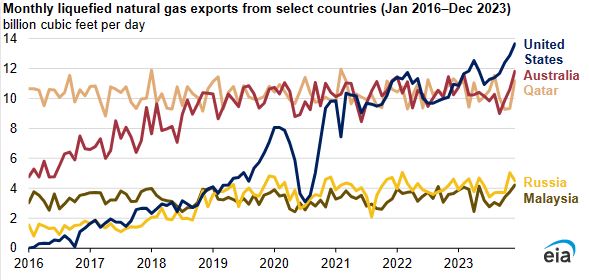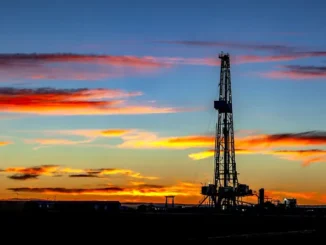
The United States exported more liquefied natural gas (LNG) than any other country in 2023. U.S. LNG exports averaged 11.9 billion cubic feet per day (Bcf/d)—a 12% increase (1.3 Bcf/d) compared with 2022, according to data from our Natural Gas Monthly.
LNG exports from Australia and Qatar—the world’s two other largest LNG exporters—each ranged from 10.1 Bcf/d to 10.5 Bcf/d annually between 2020 and 2023, according to data from Cedigaz. Russia and Malaysia were the fourth- and fifth-highest LNG exporters globally over the last five years (2019–23). In 2023, LNG exports from Russia averaged 4.2 Bcf/d, and exports from Malaysia average 3.5 Bcf/d.
U.S. LNG exports increased in the first half of 2023 after Freeport LNG returned to service in February and ramped up to full production by April. Relatively strong demand for LNG in Europe amid high international natural gas prices supported increased U.S. LNG exports during the year. U.S. LNG exports set monthly records late last year: 12.9 Bcf/d in November, followed by 13.6 Bcf/d in December. We estimate that utilization of U.S. LNG export capacity averaged 104% of nominal capacity and 86% of peak capacity across the seven U.S. LNG terminals operating in 2023.
Similar to 2022, Europe (including Türkiye) remained the primary destination for U.S. LNG exports in 2023, accounting for 66% (7.8 Bcf/d) of U.S. exports, followed by Asia at 26% (3.1 Bcf/d) and Latin America and the Middle East with a combined 8% (0.9 Bcf/d).
In 2023, Europe (EU-27 and the UK) continued to import LNG to compensate for the loss of natural gas previously supplied by pipeline from Russia. Europe’s LNG imports capacity continued to expand, and we expect it will increase by more than one-third between 2021 and 2024.
The countries that imported the most U.S. LNG were the Netherlands, France, and the UK, with a combined 35% (4.2 Bcf/d) of all U.S. LNG exports. LNG imports increased in the Netherlands after the Gate LNG regasification terminal was expanded and two new floating storage and regasification units (FSRUs) were commissioned. Germany began importing LNG in 2023 when three new FSRUs were commissioned. We expect another four terminals (three of which are FSRUs) to come online between 2024 and 2027.
In Asia, Japan and South Korea each received 0.8 Bcf/d of LNG exports from the United States, the fourth- and fifth-highest U.S. LNG export volumes by country in 2023. Japan, China, and India increased LNG imports from the United States by a combined 0.6 Bcf/d compared with 2022. The Philippines and Vietnam started importing LNG in 2023; the Philippines imported LNG cargoes from the United States only in October and November.
In Latin America, U.S. LNG exports to Brazil continued to decline last year as Brazil continued to primarily use hydropower for electricity generation. U.S. LNG exports to Brazil peaked in 2021, when the country experienced its worst drought in more than 90 years.
Note: Percentages shown denote year-on-year change in U.S. export volumes. Europe includes Türkiye.




